north2north (n2n) is a sacred container
as natural as a good conversation.
a space for holding
here: feel curious
a cleansing; a liberated existence
in this timeline
there: is a place for you
home.









Prayer flag by LV
Funded by the Any Wharhol Foundations Precipice Grant; The Drinking Gourd is Nat Turner Project’s fellowship of Black & POC artists, providing an unrestricted grant to further their practices.
2019 is our inaugural year featuring:
Alice Price
Princess Bouton
Nichole Robinson
Hobbs Waters
Mikai Arion
Brit Abuya
Roshani Thakore
Benjamin Sankara
Sarah Brahim

Vitiligo Peace//The Next Three or so Decades by Christian Orellana Bauer

This photography exhibit celebrates those who claim, reclaim and/or disrupt traditional constructs of black femininity in its many forms. The images captured mark an occasion where black women/femmes were seen, counted, loved and valued. This in and of itself is a political act.
The black women/femmes we are seeking represent a wide spectrum of difference (trans women, non-binary femmes, femmes, cis women, youth, elderly, people with a range of abilities — and everything and everyone in between). It is in this spectrum where we find the beauty and power of black people.
The photographs focus on bringing out the natural vibrancy and radiance of black skin and the rich traditions of head wraps. Head wraps have a deep and complex history from their use as tools of oppression to literal crowns. This piece of fabric represents the resilience, resourcefulness, and creativity that black women/femmes have employed as a method of survival and self-empowerment for centuries. Learn more at albinaqueens.org
Project Creator: Joy Alise Davis, Executive Director of Portland African American Leadership Forum (PAALF)
Albina Queens Photography Project Sponsors Kamp Grizzly, Design + Culture Lab, Travel Portland, and Design Week Portland.
Photographer: Rob Lewis
Headwrap Sculptor: Joy Alise Davis, Executive Director of Portland African American Leadership Forum (PAALF)

Informed by traditional cell animation, questions of family and belonging, all topped with a heaping spoonful of dark humor, Carmi “Spicyyeti” TB, beckons us to explore the world of The Damonia Family. Visit spicyyeti.com/damoni/a
Curated by Maya Vivas

Looks like It’s the mean black girl’s birthday again. 🎈Go and wish Bouton a #FestiveSelfness and join her in her denim wonderland. This opening features a live performance by Bouton and a screening of "Float Bitch" by Evan James Atwood and the birthday girl. There will be CAKE 👀
Curated by Maya Vivas

In "strategies for displaying unknown variables" Alan Page invites us to navigate decontextualized visual disturbances. Using variations of the screen, they implore us to engage with the unrecognizable, challenge us with various barriers to seeing, and beckon us to explore in a playground of digital glow, broken files, & machine learning.
Curated by Maya Vivas

Alan Page
STATEMENT
Alan Page (a.k.a. [sic][redacted] ) is a Portland-based glitch and new media artist. Through mixed physical media, intentional software misuse, and --more-than-occasionally-- chance, they create decontextualized visual disturbances that aim to exploit the spine itching discomfort that comes from unexpected results. Influenced by (and a lover of) the old, broken, probably ruined, and can’t-be-bothered-to-fix, Page creates layered, sometimes dissonant media that are simultaneously pure experimentations and an odd cipher to visually narrate their process of digesting their surroundings.
BIO
Alan Page (a.k.a. [sic][redacted]) (b.1987) is a new media artist who focuses primarily on glitch art as a means to interpret the physical and verbal ambiguity in everyday communication--objects and places included. Born in Washington and raised in Arizona and Georgia, they received a B.A. in visual communication from Savannah College of Art and Design in 2009. They are currently based in Portland, Oregon and have most recently exhibited in the 2018 /‘fu:bar/ Glitch Art Festival in Zagreb, Croatia.
w: sicredacted.com | ig: instagram.com/sic_redacted

In Alien ate d Rhy thm* Hiba Ali and Jonathan Chacón disrupt the traditional white-wall gallery with the color orange, bubbles, a train set, and foam tiles.
Ali, in her video Abra (2018), is in conversation with Amazon’s customer-obsessed mascot, Peccy. Their discussion about working-class labor, surveillance, and bubbles (economic, social and soap filled), literally paints the space orange. She contends that orange is the contemporary color of labor and danger, it is racialized and classed.
Chacón’s installation, I shit in my tub, I piss in my sink, I miss my mother (2018), is a text piece made of puzzle foam tiles embedded with objects, that span the gallery floor. The text is addressed to his mother and the character, “Mark/Marc.” Both the text and objects, serve as a frame for Chacón to discuss his interest in collage, emotional instability, and world building.
Both Ali and Chacón question the circumstance of their surroundings. Through their experiences, a new space has been created. Upon entering Alien ate d Ry thm, we as viewers must ask: How do queer people of color, repetitively move through environments designed to work against them?
Organized by Yun Yu Chiu
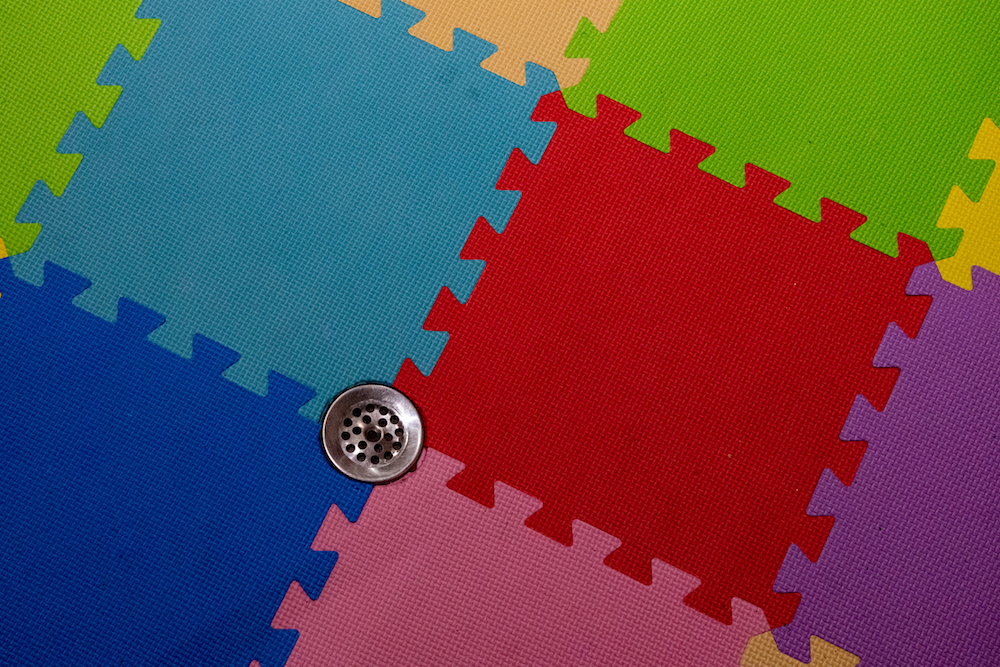


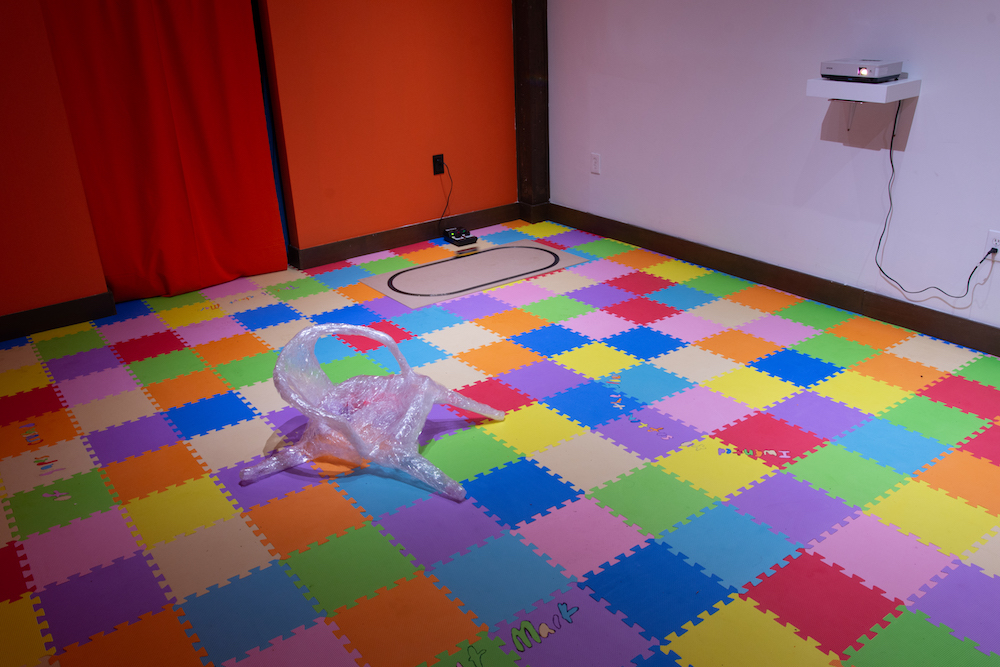
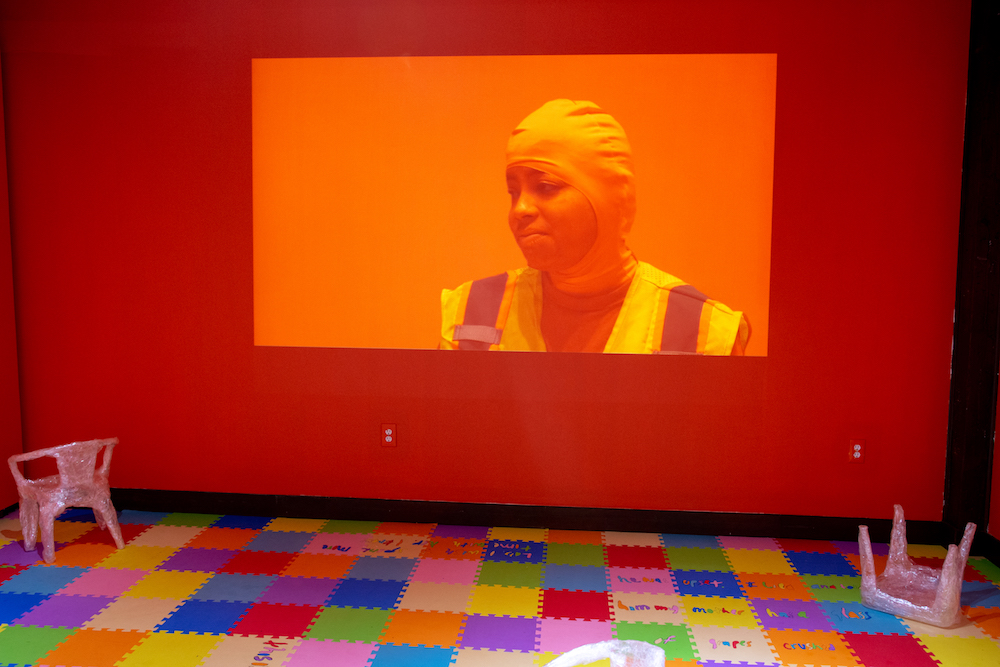
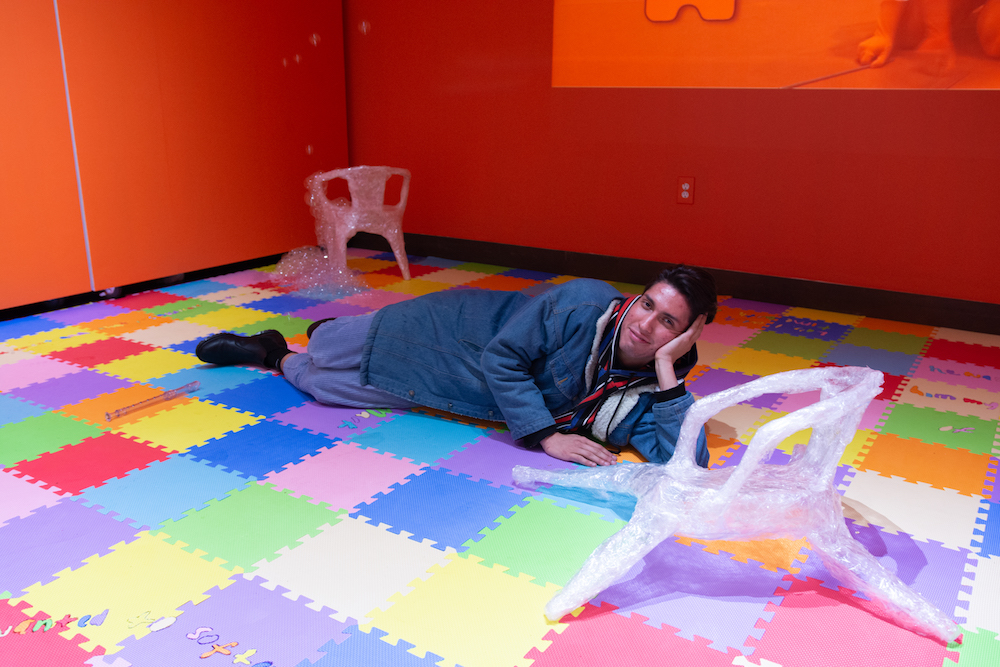
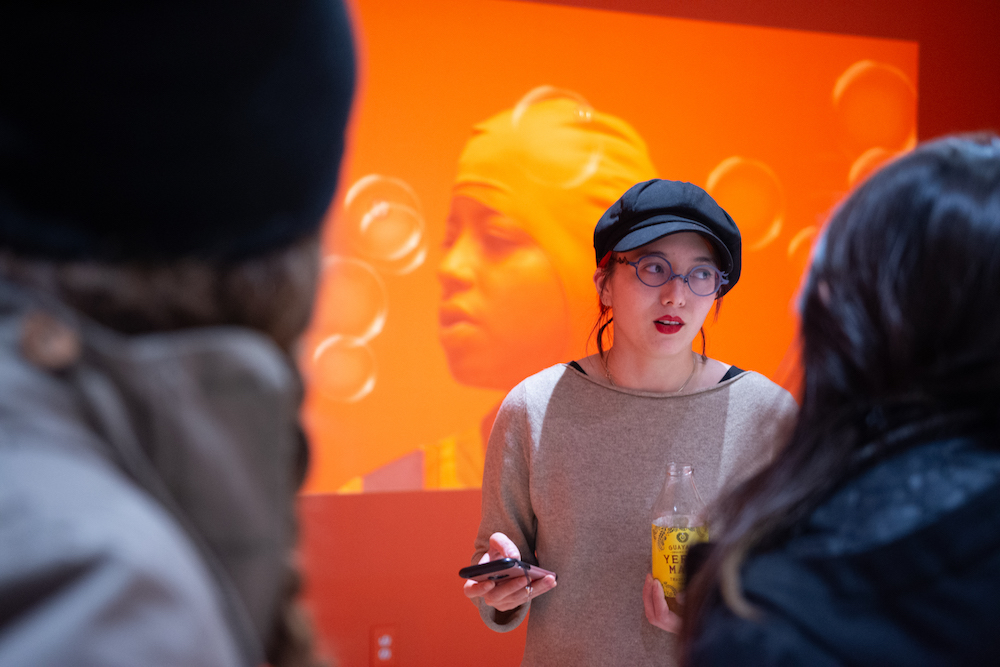
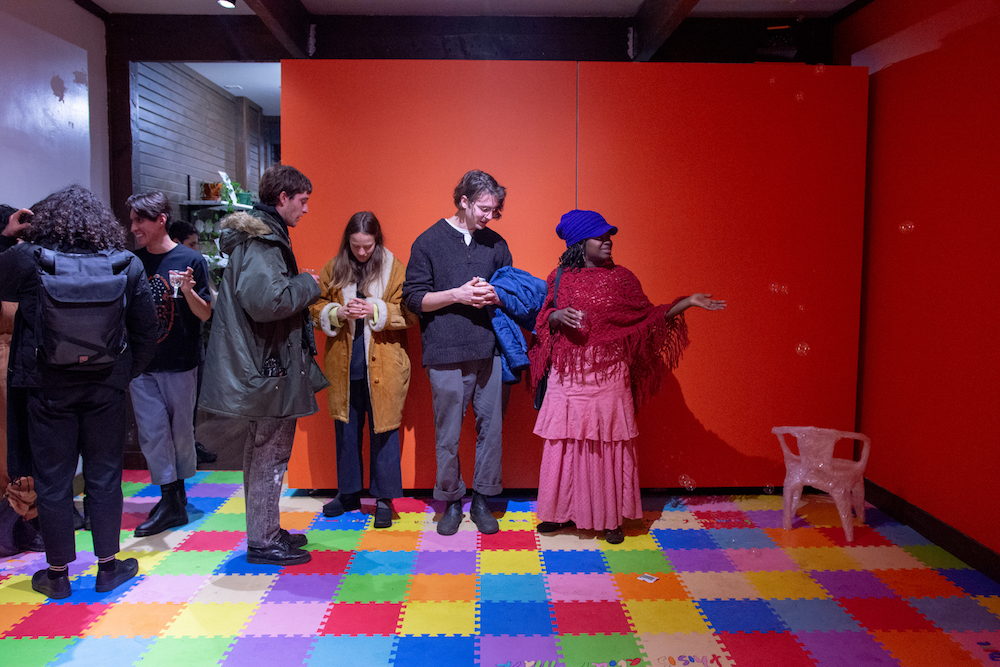

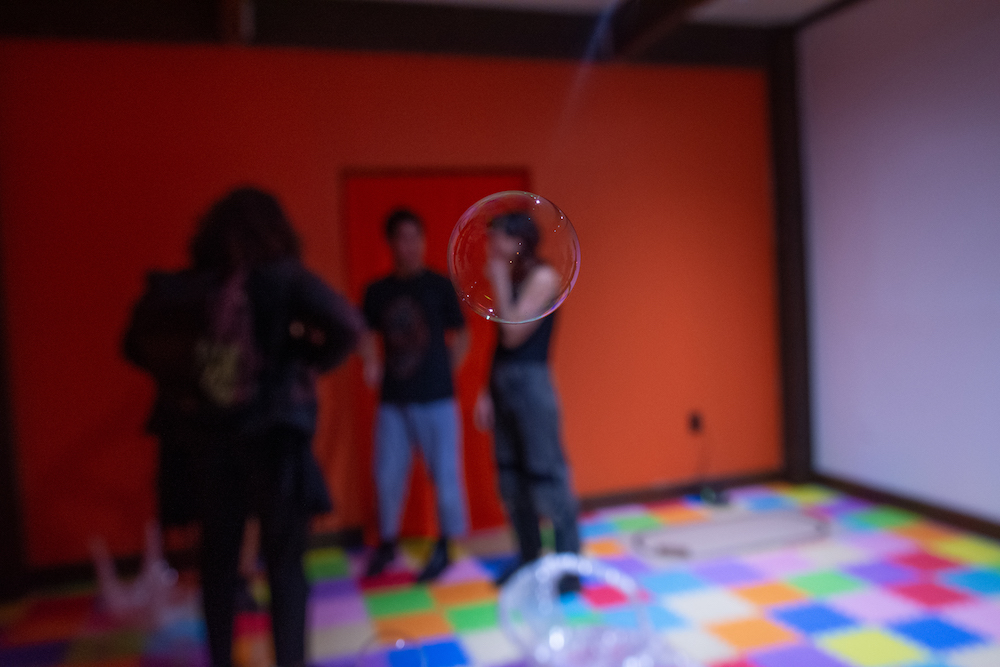
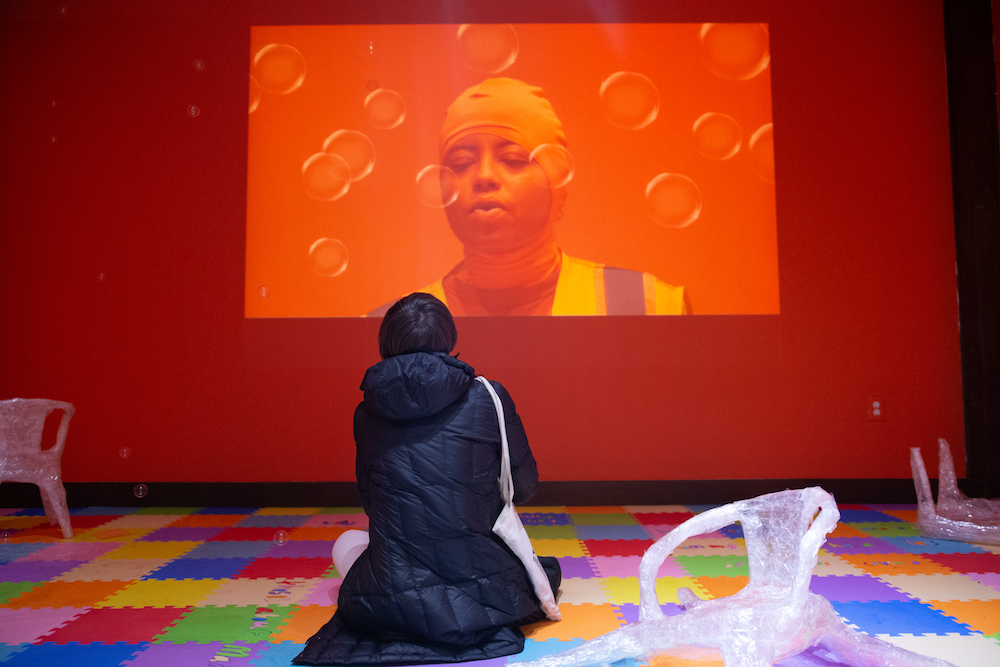

Hiba Ali
Hiba Ali is a new media artist, writer, curator and musician from Chicago, Illinois, U.S.A. Her performances and videos concern music, labor and power. Her performances as H1BA sample her immigrant, black, brown, and refugee ancestry. She believes in the power of her ancestors, queerness and Sufi Islam. She conducts reading groups addressing digital media and workshops with open-source applications and technologies. She is a PhD candidate in Cultural Studies at Queens University, Kingston, Canada. She has presented her work in Chicago, Stockholm, Toronto, New York, Istanbul, Detroit, London, Riga and Dubai.

Jonathan Chacon
Artist Statement
My work reflects a world of personal and generational repetition. Growth is rapid and brought on by a single action, a shift in environment, or artifact. A place can spark a memory and teleport you to another place all together. I use flashback, recollection, and introspection as way to play with the idea that even though our bodies may be growing, we may not be mentally and emotionally maturing. The only chance for personal growth is reflection.
Bio
Jonathan Chacón is an Los Angeles-based interdisciplinary artist whose work incorporates performance, writing, installation, sculpture, photography, and video. He has attended Yale School of Art, Skowhegan School of Painting and Sculpture, and School of the Art Institute of Chicago (SAIC). He has also been invited as a visiting artist at California Institute of the Arts (CalArts).
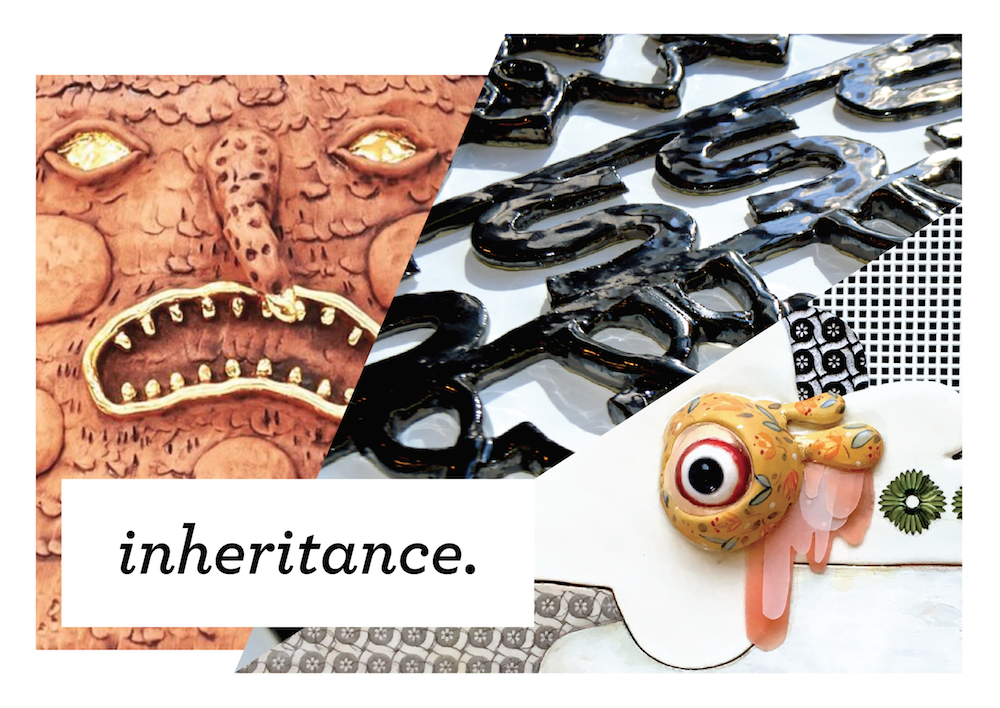
Inheritance weaves together the talents of April Felipe, Habiba El-Sayed and Natalia Arbelaez, whose work engages ideas of selfhood, be it constructed or obligatory. Each of theses artists use ceramics as a tool to question: who is hyper visible and who goes unseen? Whose identities are anchored and who is left with a sense of loss in search of belonging? And finally, how much power do we truly have in correcting the course of our inherited paths? Through personal narrative, they challenge us to reflect inward and explore how our complicated pasts affect our present understanding of the self.
Curated by Maya Vivas

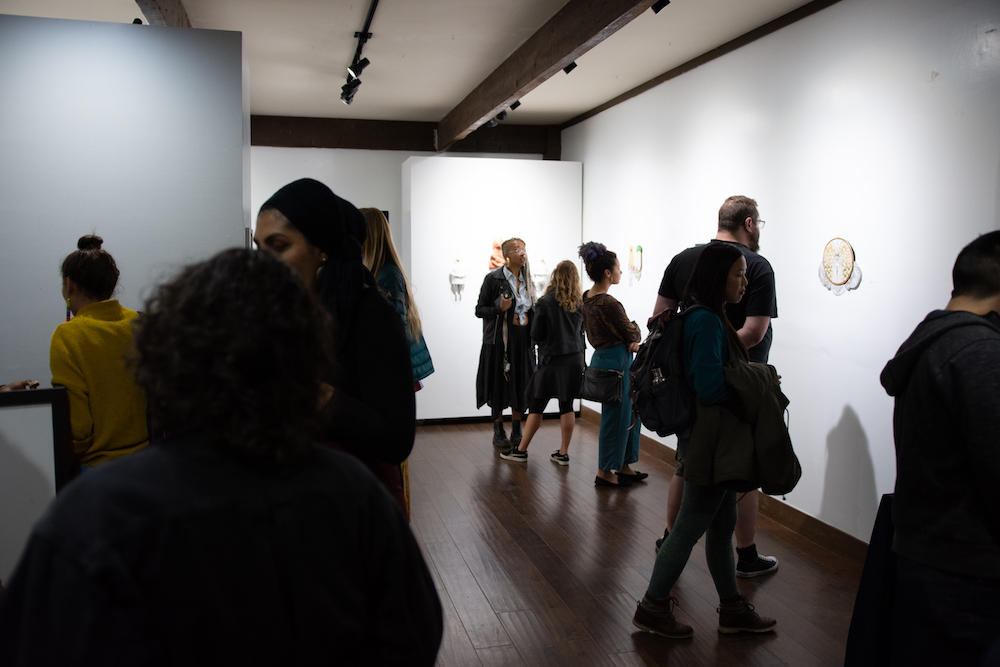
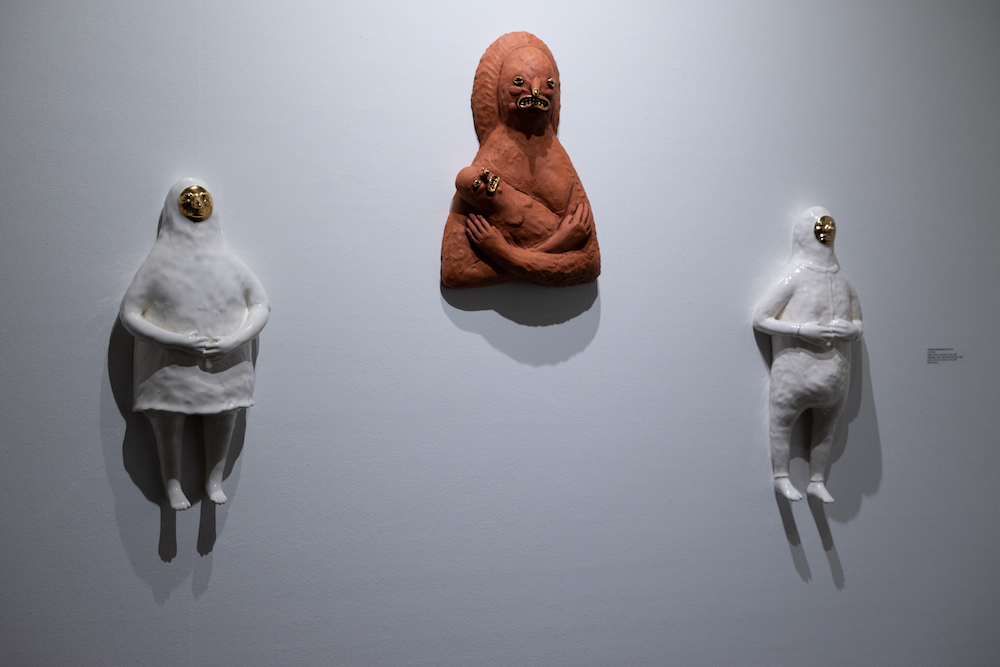

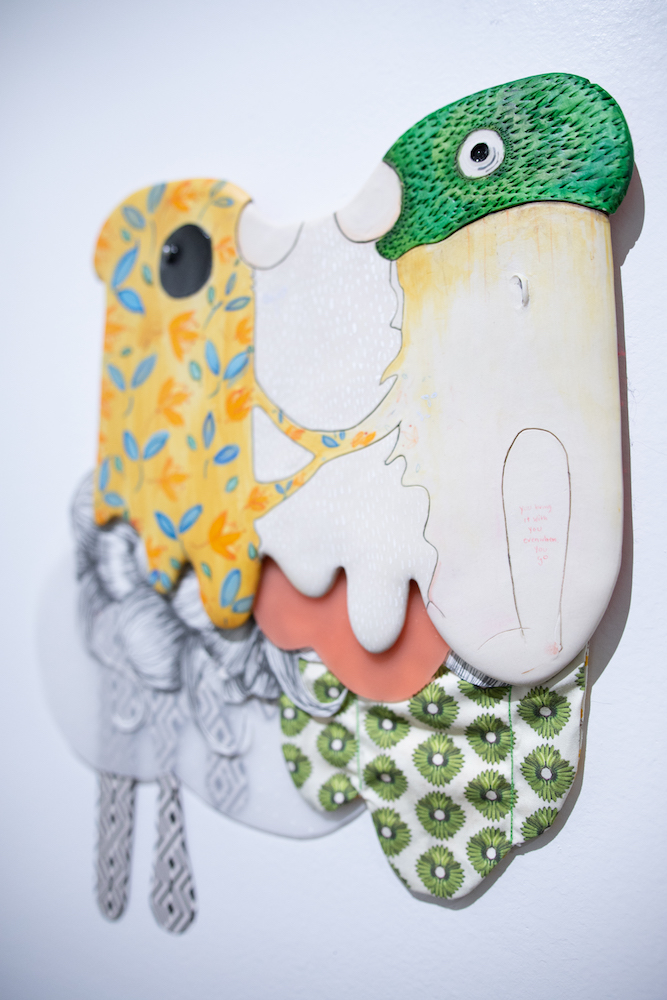

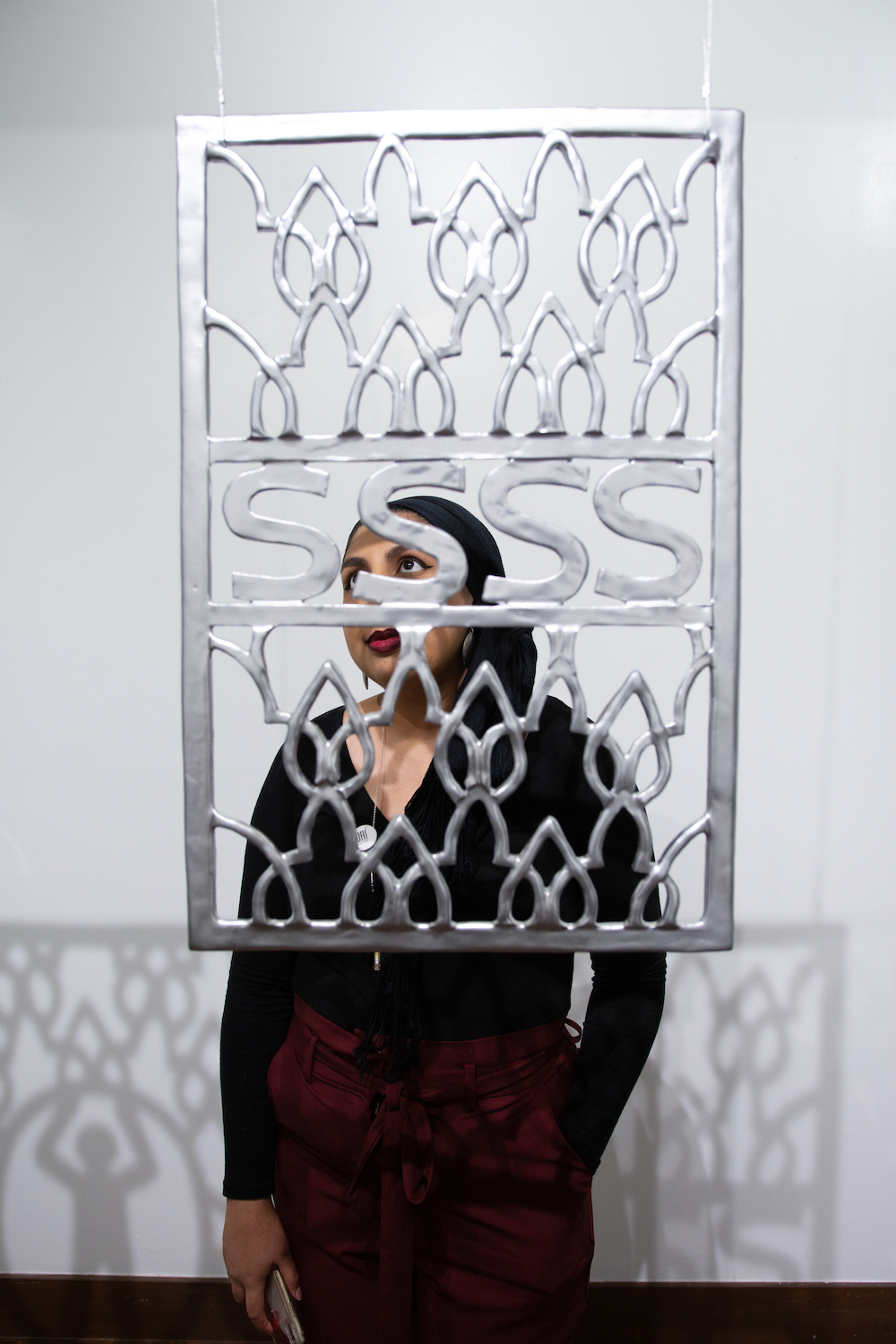

April Felipe
Artist statement
Growing up, people begin to deal with the idea of identity, not just who we are but how we place ourselves within groups beyond our families. For me, this placing became a cultural question. As my parents were from the Caribbean, I was connected to multiple cultural groups. However having grown up here in America and not fitting the visual stereotypes of my heritage, I never felt like I truly belonged to any of those cultures. I became aware that the way I presented layers of my past could be used to validate my desired place within these groups. Reflecting on my struggle, I began to question the way we construct personal history in service to our desire for belonging. I consider the tale of The Ugly Duckling, a narrative that perpetuates visually belonging, and the reward of finding ones “true” place, in conjunction with issues of colonialism. Through the layering of materials and patterns, historical, found, and invented my work explores this narrative and the constructed nature of the past to reveal our desire for belonging.
Bio
April Felipe was born in, Queens, New York. She received her B.F.A from the New York State College of Ceramics at Alfred University and her M.F.A in Ceramics from Ohio University. April worked at Greenwich House Pottery, taught at Ohio State University and Ohio University. In 2017 she was named one of Ceramic Monthly’s Emerging Artist. April has participated in residencies at Watershed Center for the Ceramic Arts and The Archie Bray foundation. April has set down roots in Albany, Ohio with a home studio, she currently works for the Dairy barn Arts Center.

Habiba El-Sayed
Inspired by Islamic architecture and human vulnerability, Toronto-based ceramic artist Habiba El-Sayed uses a variety of materials, performance and temporal techniques to illustrate her concepts. Her work focuses on connecting to, exploring and interpreting aspects of her identity, particularly as a Muslim woman living in a post-9/11 world.
Habiba holds an Advanced Diploma from Sheridan College in Ceramics (2014) and a BFA in Ceramics from the Nova Scotia College of Art and Design (2016). Her work has been shown across North America and she is currently a resident artist at Harbourfront Center in Toronto.

Natalia Arbelaez
Artist Statement
I was born in Miami, Florida but shortly after my birth I immigrated to my mother’s country of Colombia, Medellin. I would return to the states at the age of four and assimilate quickly learning English and forgetting Spanish within a month. Throughout my life, I have always questioned my identity and have felt a sense of loss.
With creating work, I could fill that loss and I have been able to reconnect with my heritage. My work serves as a bridge to research my history and culture while aiming to preserve. I look to the history of Latin American and Amerindian people and work with how these identities are lost through conquest, migration, and time, gained through family, culture, exploration, and passed down through tradition and genetic memory. I use these influences to contribute to a contemporary dialogue while simultaneously continuing the work of my ancestors. There has been so much loss and stigma of these communities that it is important to me that my work celebrates and honors them.
Bio
Natalia Arbelaez is a Colombian American artist, born and raised in Miami, Florida to immigrant parents. She received her B.F.A. from Florida International University and her M.F.A. from The Ohio State University, where she received an Enrichment Fellowship. She completed a yearlong residency at the Clay Art Center; Port Chester, New York as a Barbara Rittenberg Fellow and was awarded the 2016 Inaugural Artaxis Fellowship that funded a residency to the Watershed in Newcastle, Maine. Her work has been exhibited nationally, in museums, galleries, and included in various collections such as the Everson Museum and The Frederik Meijer Gardens. She has been recognized by the National Council on Education for Ceramic Arts as a 2018 Emerging Artist in the field. Natalia is currently a resident artist at the Harvard Ceramics Program, Office of the Arts at Harvard University where she is researching pre-Columbian art and histories.

Bringing together the work of Raychelle Duazo, Lilian Dirrebes, Emma Kates-Shaw & Adam Ponto: Stratum explores the practice of tattooing through the lens of race and gender in an industry dominated by misogyny, racism and colonization. By focusing on the work of those with multiple marginalized identities and those with direct cultural ties to the practice of body modification, we begin to deconstruct how the industry and practice have manifested. We carve out a place for artists who make a transformative place for healing, reclamation of self and ancestry. Stratum seeks to reveal the multitudes that tattooers are capable of as artists, storytellers and activists.
Curated by Leila Haile.

Adam Ponto
Artist Statement
My process examines cultural roots feeding modern society, and the ancient stories that influence our psyches to this day.
Melancholia is a series of reflections and mantras created while surviving with chronic mental illness rooted in cultural and genetic trauma.
Bio
Adam Ponto is a multidisciplinary artist living in Portland. His current focus is centered around tattoos, drawings, and watercolor. His work explores recurring existential and spiritual themes found across human societies. Within each piece there are explorations of fundamental truths and collective healing.

Lilian Ongelungel
Bio
Lilian is a Palauan artist and cultural worker from Portland, Oregon. In the last decade, they've devoted their work to empowering Pacific Islander communities in the Pacific Northwest. While her artistic roots are grounded in painting and illustration, she has also uses other means, ranging from writing and storytelling to tattoo and woodworking, as vehicles for exploring the intersections of Pacific Islander diaspora, queer identity and matrilineal legacy in her works. Outside of creative endeavors, Lilian is a communication professional in the Portland Metro Area and serves her communities in various volunteer capacities.

Raychelle Duazo
Artist Statement
As a queer brown femme who creates, I am constantly trying to make art that reflects the vibrancy, warmth, vulnerability, and power of marginalized communities. I firmly believe we love and understand ourselves (and one another) better when we see ourselves reflected in a positive way.
Bio
Raychelle Duazo is a queer femme Filipina-American illustrator from the Pacific Northwest. Artistically, her specialties include portraits, florals, and typography. Her work focuses on themes of love, heartbreak, grief, culture, diaspora, and identity.

Works by Alisha Ware, Avonlea Raschdorf, Celestina Nunez, Christian Orellana, Elena Ali, Hobbs Waters, Julia Martinez, Paola De La Cruz, Ryo Bangs, Sophia Schultz, & TJ Brown
Ori Gallery is pleased to announce: Emergent. This exhibition features the work of eleven young queer/trans/artists of color who are taking their place in wider conversations of the art world. Emergent will facilitate and continue the dialogue in what it means for our youth to cultivate an artistic practice and share their opinions, ideas, dreams & talents.

Alisha Ware
Artist Statement
I find inspiration in the power and subtly femininity possesses. It exists despite everything that has been thrown at it. This piece is a representation of personal and media fueled ideals emerging as an unfamiliar self portrait. I see artists in their work often, intentional or not, and this simply embodies me as a person and artist. I’ve painted this work using acrylic, the laborious task of molding acrylic into all the things my mind and hand can create is an important aspect of the process. It helps blur the line between art and the artist.
Bio
Alisha Ware is a Portland, OR based painter and digital artist. She has been creating work for 6 years. In her work, she enjoys expressing and molding the ideals of beauty, gender, sexuality, and race. She gravitates toward acrylics with pastels, bold accent colors, and earth based palettes. Currently, Alisha is working towards her Associates Degree at Portland Community College and is the Artist in Resident at the Queer Resource Center on campus. Alisha is currently beginning to obtain experience in art curation; preparating for a show at North View Gallery and putting together a gallery space in the center for queer and trans student artists.

Avonlea Raschdorf
Artist Statement
I became infatuated with the relation to space and the cleanliness of form Japanese porcelain wares have. The pieces have a sense of care, symmetry, and the structure of the forms evokes thoughts of architecture. I wanted to marry this influence with internationally common household vessels; most notably the vase, the bowl, and teawares. The work presented is a study; I wanted to see how I could push my own perceptions of symmetrical form and line. Then through my treatments of glazing I sought out to adduce flux and life. With specialized attention to each object dismisses the ideology of mass production while celebrating the grandeur in the mundane. I seek to create something evocative. Functionality is not the main objective while throwing; shape is the central focus. These works are high fired in either a reduction, oxidation, or wood kiln. Referencing antiquated Japanese celadon and tenmoku glazes, I contemporizes these methods by over-glazing using a micro-crystalline substance, creating drips and using a more pastel celadon.
Bio
Avonlea Raschdorf is a craftsperson and ceramic artist residing in Portland, Oregon. Throughout the six years Raschdorf has been working with clay he has taken on many roles ranging from: ceramic lab technician, apprentice, artist assistant, and gallery preparator. He is influenced by themes relating to identity, the urban landscape, and unique forms. Raschdorf aims to connect relatable vessel forms with life's complexities, and his own ideologies about how he perceives the world. His work strives to bring in three key design elements: color, space and its relationship to the work, and how line appears within his work. Raschdorf has shown in an variety of galleries in and around the Portland area; including exhibitions with the National Council on Education for the Ceramic Arts (NCECA).

Celestina Nunez
Artist Statement
Celestina Nunez's educational background has made her curious about art as activist practice. Connecting global issues to local communities, she aspires to create a body of work that disrupts complacency of dominant perspectives. Her current projects focus on the growth of U.S. immigrant detention centers and the people they imprison. By juxtaposing the humanity of her subjects with the inhumane imprisonment that face, she aims to expose the true nature of these institutions.
Bio
Celestina Nunez is a 23 year old self-taught artist that primarily works with acrylics, oils, and pen. Her work with non-profit organizations serving immigrant communities in Portland has played a vital role in shaping her perspective. Raised in Salem, Oregon, she graduated from PSU with degrees in both International Studies and Women’s Studies, and has since made Portland her home. She has been drawn to create as a method to express queerness and Latinx identity in a dominantly white community.

Christian Orellana
Artist Statement
The work displayed here works to both empower people of color as well as call attention the glaringly obvious white washing of influential figures throughout history (in particular Jesus Christ). "Jesus Was Brown" works to fight against this white washing and reclaim the powerful religious figure as a member of communities of color rather than privileged white communities. "A Mutt is a Beautiful Dog" functions as an argument in favor of interracial relationships, platonic, romantic, and otherwise. In this way it hopes to fight against racism, romantic segregation, and call attention to the changing makeup of the United States as well as frame it in a positive light; a hopeful and happy view of our future.
Bio
Christian Orellana Bauer is an artist raised, and based in Portland, OR. As a mixed race person his work often hopes to call attention to the nuances and complexities surrounding discussions about race as well as push these conversations further. Pulling from his own experience as a person of color in a mostly white city has heavily influenced his work. Themes in his pieces also often include gender, mental health, the impending doom of our environment, the exclusivity of the fine art community, as well as art for arts sake. He works in a variety of mediums including painting, printmaking, sculpture, film, photography, music, collage, installation, and more.

Elena Ali
Artist Statement
My art takes a critical, yet whimsical look at the works that played an early influence in my creative pursuits. It quite often takes on the idea of “high fantasy” and makes it less white and less cishet, offering, I hope, alternative narratives and looks for young and old minds alike to play with and explore. The portrait that is presented today is for a particular project that I have been playing with in my head for years and only recently have I developed the skills to accurately represent it to the outside world.
Bio
(elena) Ali (they/them/theirs) was born in West Philadelphia, but spent the majority of their formative years in New York City reading books about worlds they did not live in, while commuting three hours a day to get to school. They are currently a rising Junior at Reed College, getting a B.A. in chemistry, while working as an Events Coordinator for the Reed Multicultural Resource Center and as one of two Training Supervisors for the Reed Research Reactor. They have, in the past, worked as a graphic and web designer and some of their work can be found at http://people.reed.edu/~mcknighe/.

Hobbs Waters
Eleven year old Hobbs is an exceptional dancer as well as a cellist, and artist. He has a t-shirt line which he sell through his online store WWW.CITYTROLL.COM to help fund his dance education. Hobbs primarily dances Ballet, but he also does Contemporary, Hip-hop, Modern, and Jazz. This summer he will be attending Nutmeg Ballet Conservatory and Nashville Ballet. Both programs he received full merit scholarships. Hobbs is a showing artist, in the past he has mainly focused on a variety of pen and ink animals. Now he has moved on to working on abstract paintings, each painting makes a political statement. All his paintings correspond with social justice issues.

Julia Martinez
Artist Statement
Everyone, at some point within their lives, was a fairly impressionable child. Although, despite being repeatedly told numerous times that specific aspects of your identity (such as gender, sexuality, and beliefs) were predetermined for you I always thought otherwise and continued to question this enforced behavior. My earliest memories primarily revolved around this desire for the defined self-image as an attempt to understand myself, as well as this inherent yet emotive vulnerability that craves general belonging. Facing personal growth over the years allowed me to acknowledge said childlike sense of curiosity/questioning and as an artist learned how to project those considerations within my work as a prominent source of subject matter. In both Quiero Destrozar Julietta and Reach Out and Touch Faith (Personal Jesus) I primarily work with miscellaneous items and their formal associations to only distort and alter their assigned meanings through influences of sexuality, religious iconography, and queer politics. Through images, fonts, text, textiles, materials that are typically considered ‘craft’ rather than ‘fine art’, I manipulate in order to not only convey a message about a queer person’s upbringing but a portrayal of universal experiences within the queer community of coming to terms with your own labels and identity.
Bio
As a cross-disciplinary artist, Julia Martinez surrounds themselves with a melancholic understanding of curiosity that continues to encourage them to explore subject matter through unconventional means of expression. Their emphasis on maintaining the raw essence of the mediums they deal with, such as mixed media, painting, and ceramics, correlates to incongruous influences as well as a personal sense of identity through texture, imagery and above all the essential use of Iconography. Julia’s works have been displayed in numerous exhibitions including Whittier High School’s Student Art Show and Western Oregon University’s Juried Student Art Show several years in a row. Julia is an aspiring art student who recently earned a Bachelor of Art in 2017 and is currently enrolled in Western Oregon University’s Bachelors of Fine Arts program with a ceramics concentration.

Paola De La Cruz
Artist Statement
The lack of female representation within the art world is undeniably insufficient; representation of female artist of color is even less. For this, Women of Color in the Arts is a series portraits that pays tribute to the women of color who have used their art to awake conversations and create unapologetic statements. The series uses paper cut and layering techniques to fabricate a collection of portraits, each unique, as they each strive to capture the individuality of the artist portrayed.
Bio
Paola De La Cruz is a Dominican American illustrator currently working on her Bachelors of Fine Arts degree. Being raised in the Dominican Republic, Paola was exposed to beautiful landscapes and a vivid art culture, as well as some darker themes of interpersonal and individual oppression. Moving to Boston, Paola was exposed to a more perceptible culture of injustice. Her work incorporates both retail and found materials; in inspiration of collage and quilting. Her work ranges from conceptual to portraiture touching upon themes anywhere from social justice, coming of age and fantasy

Ryo Bangs
Artist Statement
My art is all about identity; I want to convey my thoughts on gender and attraction though my portraits, using color theory and composition. I started drawing without a purpose in my art, and only through the process of coming out and ingraining myself in gay culture did I really figure out what I wanted my art to be about. But overall? I just want everyone to know I’m gay.
Bio
Ryo Bangs is a gay nonbinary boy from Portland. He works in both traditional and digital mediums, with a focus on digital painting. His art is influenced by his mixed cultural background, and his experience as a member of the LGBT+ community. Inspired by his love for color, he strives to depict self expression through playful portraiture. He has been involved in a few local shows through educational opportunities, and is currently studying apparel design.

Sophia Schultz
Artist Statement
Tibabita en mi corazón belongs to a series of multimedia sculptures of the weight of inter-generational memory. Interweaving fading photos taken by the artist, their mother, a Colombian immigrant, and family photos, they are held up by what is lost and what remains.
Bio
Sophia Schultz Rocha (b.1994) is a non-binary Colombian-American artist, photographer, and filmmaker. Sophia was born and raised in Sarasota, Florida and received a B.A in Anthropology from New College of Florida in 2017. They now live in Oakland, California where they continue their multi-disciplinary practice with memory, trauma, and intimacy.

TJ Brown
Artist Statement
(In reference to featured work “HB Fuck You”) This is a poster I made 2 years ago in response to HB2 which was passed in North Carolina. HB2 is a bill that was a passed to enforce everyone to go to bathroom that correlate to their assigned gender at birth. I was appalled that this discriminatory bill was passed and made a poster basically just saying let us fucking pee in peace.
Bio
TJ Brown is a queer hispanic black student who currently studies at Wayfinding Academy. They have been a visual artist about 6 years. Most of their artwork is with acrylic paint but have been experimenting with other mediums. Some of their work touches on social issues and others are just things from their imagination. for more artwork, follow them on tjbrownart on instagram.

Over a two week period, artists Lo Smith & Nadia Wolff, meditated on 'exotic' bouquets of live flowers to uncover methods of responding to the prompt “how does a flower become a pattern?”. While working independently of each other, each artist used laser cut stamping and experimental printmaking techniques on cotton rag paper to explore their respective flowers. The manipulations, deconstruction, and natural decay of the flowers brought questions of liminal objects, invasive species’ roles in environmental degradation, and flowers’ relation to the cyclical nature of time. In rejecting the restraints of purely formal motivation, these works also contend with questions of how black queer bodies within institutional space inherently disrupt and finds themselves incapable of conforming to demands for objectivity. The result: Linoleum Flowers.




Lo Smith
Artist Statement
Lo Smith is interested in material culture, self determined healing processes (also known as folk medicine), and the potential of memory and personal archiving to disrupt state and interpersonal violence on black bodies and queer bodies. In this series of work, Lo attempts to explore the practice of print as catharsis through pushing back on the common printmaking goal of creating perfect multiple from one stencil. In this process of ‘un-making prints’ , the artist begins to interrogate the limits and boundaries of what a printed art object is, and attempts to investigate it usefulness as a communicative tool. In this work and beyond Lo wants to further explore the possibility of individual printed objects as tools to connect folks, address trauma and foster healing.
Bio
Lo Smith was born and raised Cleveland, Ohio and as a result is both aggressively midwestern and unapologetically black. Lo is currently based out of Providence, Rhode Island while they pursue their MFA in Printmaking at the Rhode Island School of Design. Their work has recently been shown at the Cleveland Institute of Art, The Granoff Center for Creative Arts, Emerson College.They enjoy imagining radical futures, baking, and exploring botany.

Artist Statement
Nadia Wolff’s work uses textiles, printmaking, performance interventions, and text to examine intersections of black queer femme identities, particularly within a Caribbean context. Their work is interested in the historic interactions between colonial religious and linguistic codes with the linguistic and religious forms— those of Kreyol and Vodou— that developed in opposition to these structures. In defining both black Caribbean femme bodies and the trajectories of Kreyol and Vodou as a queering of colonial definitions of femininity, sexuality, and language, their work hopes to present a healing re-imagining of the intersections of race, gender, religion, and place.
Bio
Nadia Wolff is an artist, designer, and writer originally from Miami, Florida, now based in Providence, Rhode Island. They are currently pursuing a BFA in Textile Design and a B.A. in Literary Arts in the Brown University/Rhode Island School of Design Dual Degree program. They are a 2016 U.S. Presidential Scholar in the Arts, and have exhibited in Miami, FL at The Rubell Family Collection, The YoungArts Foundation, and House of Art Gallery; Washington, D.C. at the John F. Kennedy Center for the Performing Arts; and Providence, RI at the Granoff Center for the Creative Arts and the RISD Museum.

Sikelianos-Carter takes us on a journey in Femme, future-sent divinity, examining black hair as armor, weapons and symbols of royalty. These Future Ancestors are Sikelianos-Carter's response to, and escape from the many ways Black bodies are policed and dehumanized. Exploring white America's historical repulsion to Black hair and the more contemporary fetishization and appropriation of Black hairstyles within popular culture. They are the gatekeepers of rage and sadness, projections of power and freedom, cast onto an otherworldly reality.

Alisa Sikelianos-Carter
I want to live in a world in which every micro-aggression, attack on humanity, and doubt of divinity aimed at Black Women is destroyed by aggressively Femme, future sent deities. These Goddesses are completely enveloped and adorned by magnificent cornrows, dreadlocks and twists. The hairstyles act as armor and weapon, protecting and repelling wearers from white supremacy and misogyny. These are the beings I create. My wildest dreams realized; a marriage between the spectral beings we (as Black people) can and will transform into as a result of the culture we currently live in with the majesty, magic and tradition of our ancestors. These Future Ancestors are my response to, and escape from the many ways Black bodies are policed and demonized; white america’s historical repulsion to Black hair and the more contemporary fetishization and appropriation of Black hairstyles within popular culture. They are the gatekeepers of my rage and sadness, projections of power and freedom, cast onto an otherworldly reality.

Ori Gallery is pleased to present our inaugural art exhibition Elements of Reclamation.
Elements, considers the work of five black artists (Lisa Jarrett, sidony o'neal, Intisar Abioto, Melanie Stevens and Maya Vivas) coming together to challenge ideas of homogeny and create a breeding ground for reclamation. Reproducing what once was and revealing in, what is, full and pregnant with narratives ripe in complexity, joyousness, the playful, the nonsensical, the bothered and unbothered ways of being. These elements of reclamation expand beyond the single unit of body and ideas of possession. It encompasses place, culture, community, past, present and future. It is a coming together of a body of bodies conscious of their context. It is a body thinking of itself.
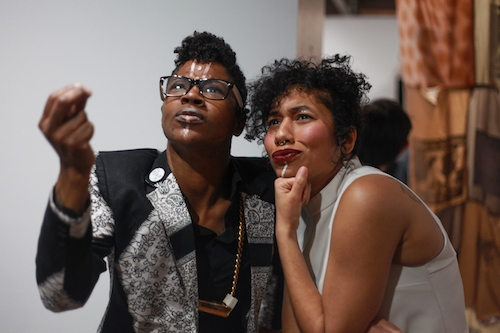
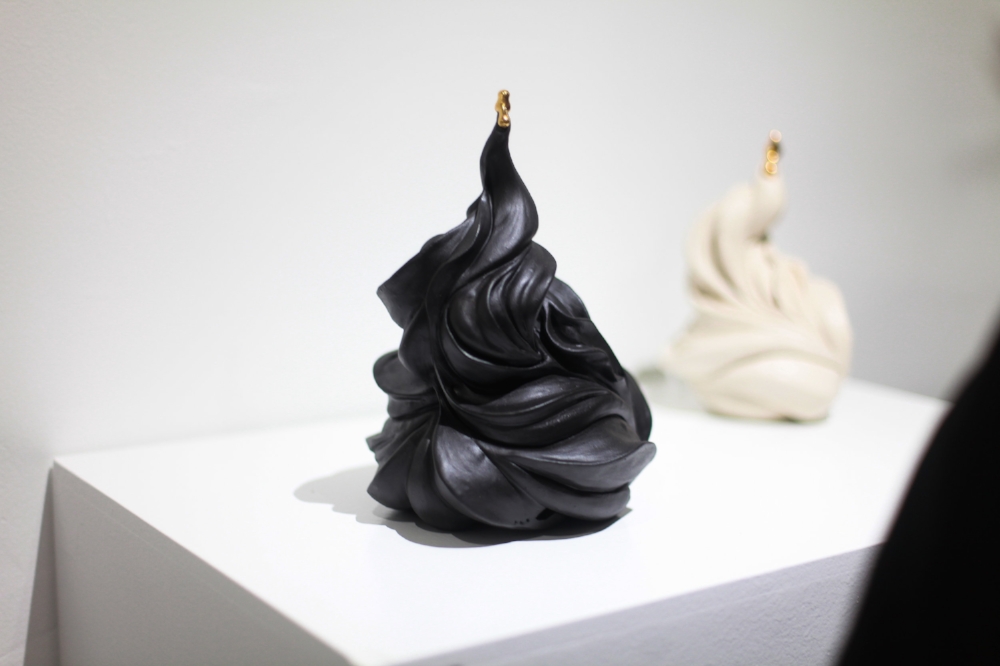

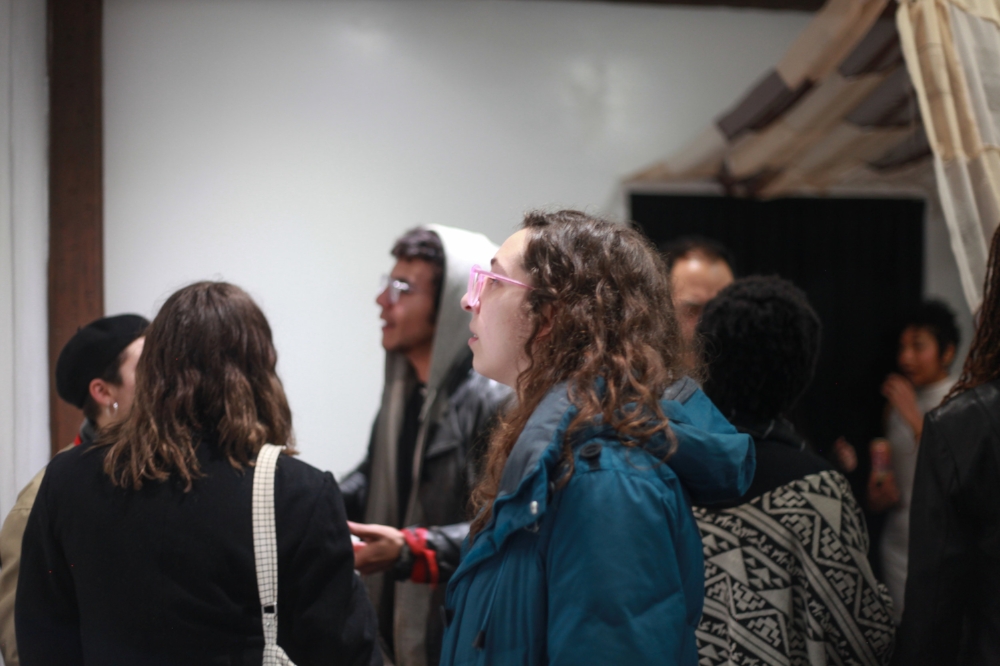
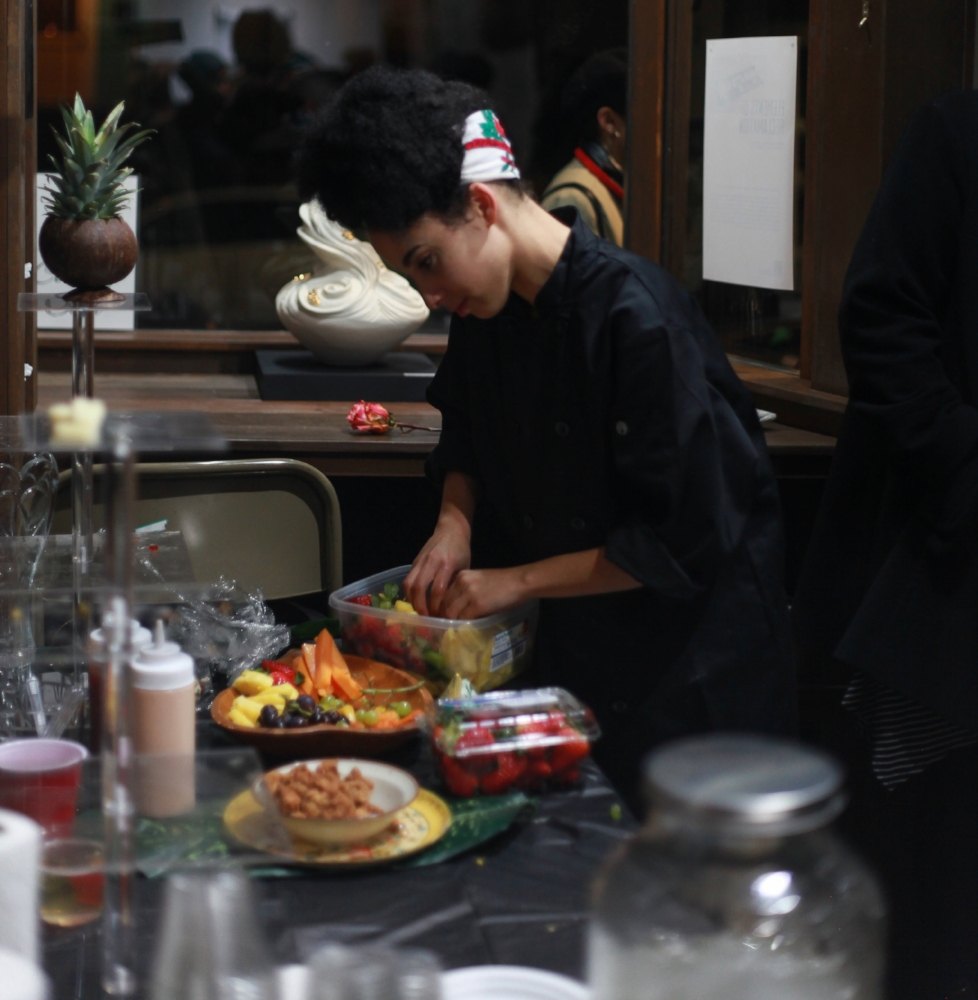
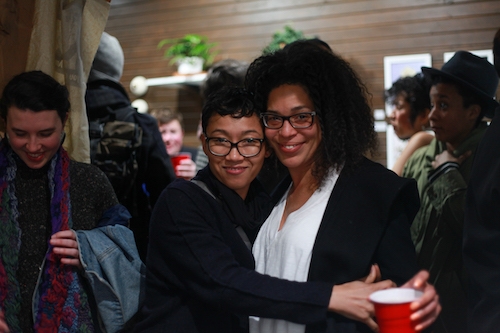

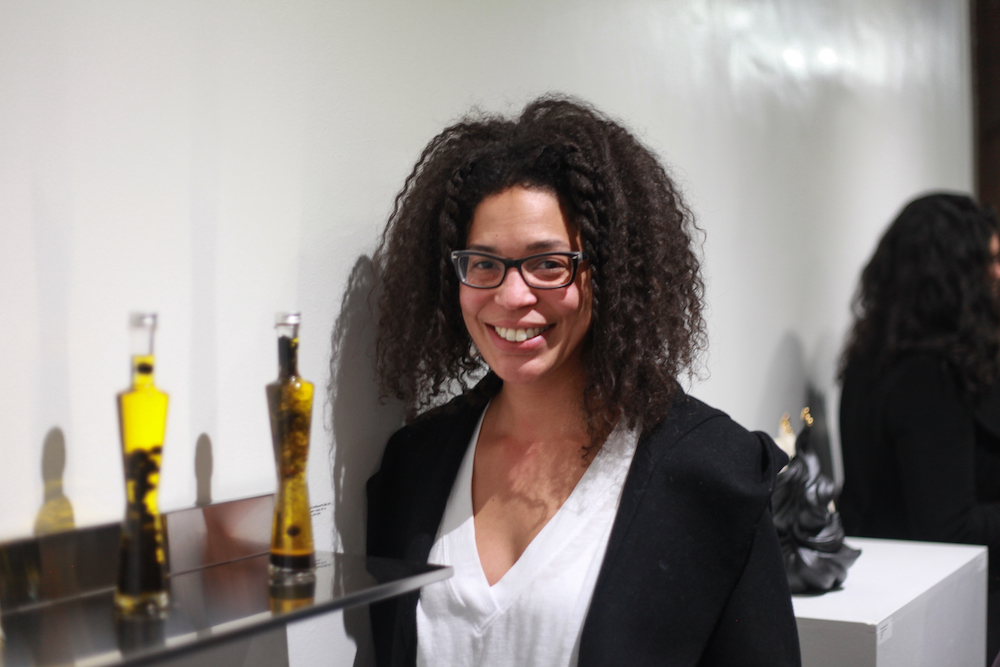

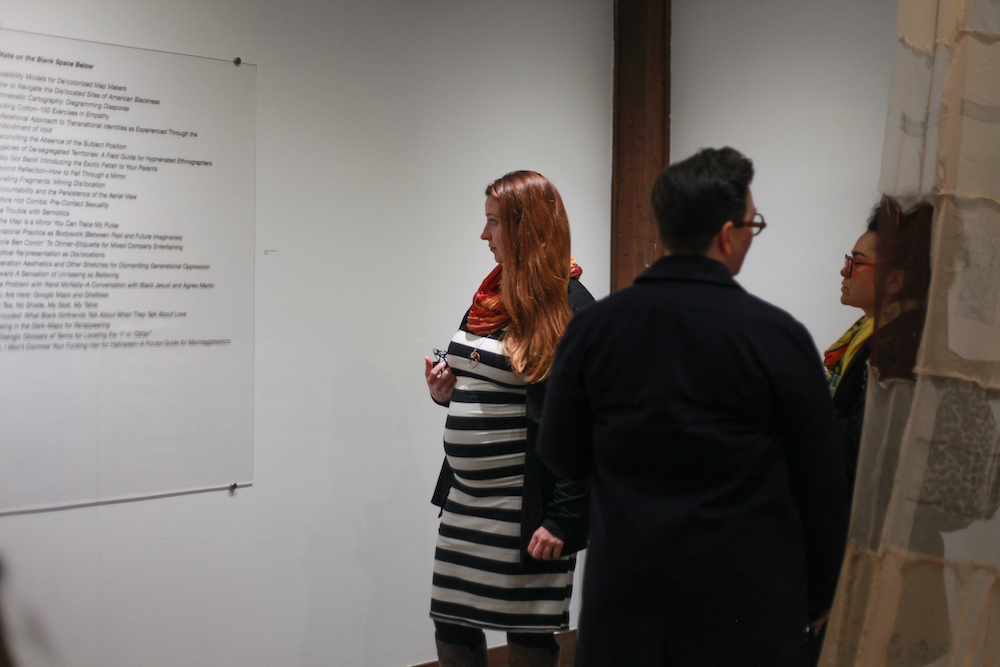
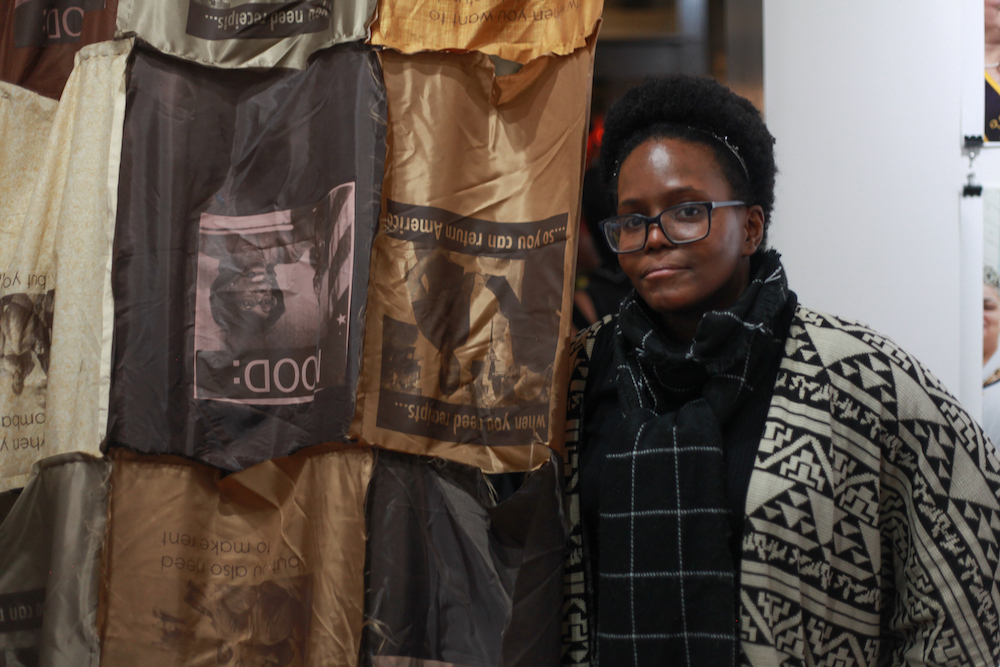

Melanie Stevens
Melanie Stevens is an artist, illustrator, and writer. She is the creator of the graphic novel, Black Picket Fence, and the co-founder, editor, and an instructor of Miss Anthology, an organization that supports and publishes racially and economically diverse young comic artists who identify as female or genderqueer. She is also the co-curator of Nat Turner Project, a migratory, radical gallery space that grants artists of color the freedom to create or express their own language within and without the parameters of racial commodification or designation. She received her Bachelor of Arts degree for Political Science from Yale University and her Master’s of Fine Arts degree for Visual Studies at Pacific Northwest College of Art.

Lisa Jarrett
Lisa Jarrett is an artist and educator. She is Assistant Professor of Community and Context Arts at Portland State University. Her intersectional practice considers the politics of difference within a variety of settings including: schools, landscapes, fictions, racial imaginaries, studios, communities, museums, galleries, walls, mountains, mirrors, floors, rivers, and lenses. She exists and makes socially engaged work within the African Diaspora. She recently discovered that her primary medium is questions.

Maya Vivas
Maya Vivas is a ceramic sculptor and graphic designer. Their ceramic sculptures have been featured in an array of galleries throughout Portland, Los Angeles and New Zealand, including venues in association with NCECA (The National Council on Education for the Ceramic Arts). In addition to being an active member at Radius Community Art Studio, they are currently Co-Director of ORI Gallery. Whose mission is to redefine "the white cube" through amplifying the voices of Queer and Trans Artists of color, community organizing and mobilization through the arts.

Intisar Abioto
Intisar Abioto is a dancer, photographer, and writer originally from Memphis, TN. With a research focus on the African Diaspora, her unique form of story inquiry as a way of life has taken her from Mississippi to Berlin to Djibouti, seeking the multifarious presence of people within the diaspora. She's the creator of The Black Portlanders, a photo essay and exploratory blog imaging people of African descent in Portland, OR. This led to research into Black life around Oregon as photographer for the Urban League of Portland’s State of Black Oregon 2015. She released her first publication, Black Portlands, in 2016.

sidony o'neal
I work experimentally across sculpture, performance, text, and sound composition—drawing conceptually on theories of blackness, abstraction, waste studies, the performance of refusal, translation/untranslatability, automata, material logic, queerness, and personal/archival technologies to consider borders, surfaces, heaps. What new modes of seeking might arise if we decenter our hope for a future based on arrival—on terminal location, fixed topography, stillness? I attempt to embrace a feeling that (s)lack, fugitively, and object-hood might have always been more valuable markers of existance.
sidony o'neal (b. 1988) was born and raised in South Sacramento, CA.